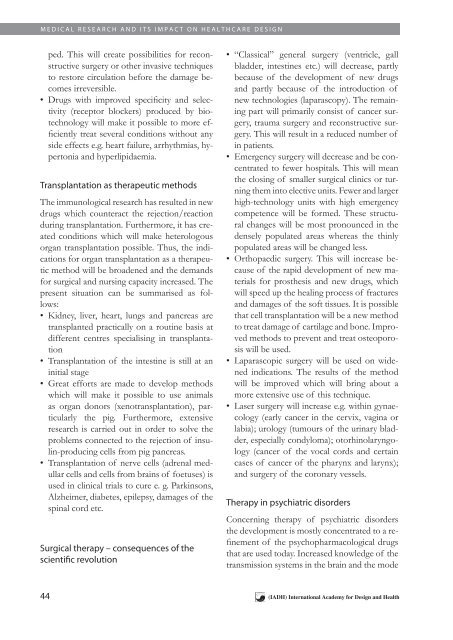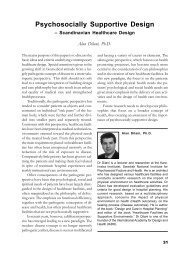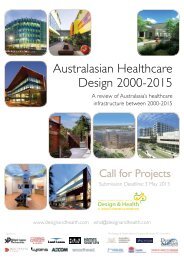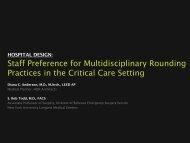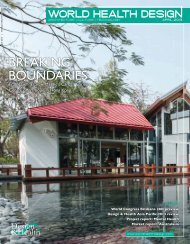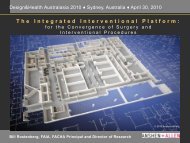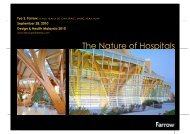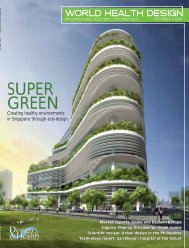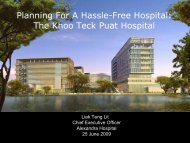Medical Research and its Impact on Healthcare Design - the ...
Medical Research and its Impact on Healthcare Design - the ...
Medical Research and its Impact on Healthcare Design - the ...
You also want an ePaper? Increase the reach of your titles
YUMPU automatically turns print PDFs into web optimized ePapers that Google loves.
HEALTH MEDICAL FACILITY RESEARCH AND ITS IMPACT ON HEALTHCARE DESIGNped. This will create possibilities for rec<strong>on</strong>structivesurgery or o<strong>the</strong>r invasive techniquesto restore circulati<strong>on</strong> before <strong>the</strong> damage becomesirreversible.• Drugs with improved specificity <str<strong>on</strong>g>and</str<strong>on</strong>g> selectivity(receptor blockers) produced by biotechnologywill make it possible to more efficientlytreat several c<strong>on</strong>diti<strong>on</strong>s without anyside effects e.g. heart failure, arrhythmias, hypert<strong>on</strong>ia<str<strong>on</strong>g>and</str<strong>on</strong>g> hyperlipidaemia.Transplantati<strong>on</strong> as <strong>the</strong>rapeutic methodsThe immunological research has resulted in newdrugs which counteract <strong>the</strong> rejecti<strong>on</strong>/reacti<strong>on</strong>during transplantati<strong>on</strong>. Fur<strong>the</strong>rmore, it has createdc<strong>on</strong>diti<strong>on</strong>s which will make heterologousorgan transplantati<strong>on</strong> possible. Thus, <strong>the</strong> indicati<strong>on</strong>sfor organ transplantati<strong>on</strong> as a <strong>the</strong>rapeuticmethod will be broadened <str<strong>on</strong>g>and</str<strong>on</strong>g> <strong>the</strong> dem<str<strong>on</strong>g>and</str<strong>on</strong>g>sfor surgical <str<strong>on</strong>g>and</str<strong>on</strong>g> nursing capacity increased. Thepresent situati<strong>on</strong> can be summarised as follows:• Kidney, liver, heart, lungs <str<strong>on</strong>g>and</str<strong>on</strong>g> pancreas aretransplanted practically <strong>on</strong> a routine basis atdifferent centres specialising in transplantati<strong>on</strong>• Transplantati<strong>on</strong> of <strong>the</strong> intestine is still at aninitial stage• Great efforts are made to develop methodswhich will make it possible to use animalsas organ d<strong>on</strong>ors (xenotransplantati<strong>on</strong>), particularly<strong>the</strong> pig. Fur<strong>the</strong>rmore, extensiveresearch is carried out in order to solve <strong>the</strong>problems c<strong>on</strong>nected to <strong>the</strong> rejecti<strong>on</strong> of insulin-producingcells from pig pancreas.• Transplantati<strong>on</strong> of nerve cells (adrenal medullarcells <str<strong>on</strong>g>and</str<strong>on</strong>g> cells from brains of foetuses) isused in clinical trials to cure e. g. Parkins<strong>on</strong>s,Alzheimer, diabetes, epilepsy, damages of <strong>the</strong>spinal cord etc.Surgical <strong>the</strong>rapy – c<strong>on</strong>sequences of <strong>the</strong>scientific revoluti<strong>on</strong>• “Classical” general surgery (ventricle, gallbladder, intestines etc.) will decrease, partlybecause of <strong>the</strong> development of new drugs<str<strong>on</strong>g>and</str<strong>on</strong>g> partly because of <strong>the</strong> introducti<strong>on</strong> ofnew technologies (laparascopy). The remainingpart will primarily c<strong>on</strong>sist of cancer surgery,trauma surgery <str<strong>on</strong>g>and</str<strong>on</strong>g> rec<strong>on</strong>structive surgery.This will result in a reduced number ofin patients.• Emergency surgery will decrease <str<strong>on</strong>g>and</str<strong>on</strong>g> be c<strong>on</strong>centratedto fewer hospitals. This will mean<strong>the</strong> closing of smaller surgical clinics or turning<strong>the</strong>m into elective un<str<strong>on</strong>g>its</str<strong>on</strong>g>. Fewer <str<strong>on</strong>g>and</str<strong>on</strong>g> largerhigh-technology un<str<strong>on</strong>g>its</str<strong>on</strong>g> with high emergencycompetence will be formed. These structuralchanges will be most pr<strong>on</strong>ounced in <strong>the</strong>densely populated areas whereas <strong>the</strong> thinlypopulated areas will be changed less.• Orthopaedic surgery. This will increase becauseof <strong>the</strong> rapid development of new materialsfor pros<strong>the</strong>sis <str<strong>on</strong>g>and</str<strong>on</strong>g> new drugs, whichwill speed up <strong>the</strong> healing process of fractures<str<strong>on</strong>g>and</str<strong>on</strong>g> damages of <strong>the</strong> soft tissues. It is possiblethat cell transplantati<strong>on</strong> will be a new methodto treat damage of cartilage <str<strong>on</strong>g>and</str<strong>on</strong>g> b<strong>on</strong>e. Improvedmethods to prevent <str<strong>on</strong>g>and</str<strong>on</strong>g> treat osteoporosiswill be used.• Laparascopic surgery will be used <strong>on</strong> widenedindicati<strong>on</strong>s. The results of <strong>the</strong> methodwill be improved which will bring about amore extensive use of this technique.• Laser surgery will increase e.g. within gynaecology(early cancer in <strong>the</strong> cervix, vagina orlabia); urology (tumours of <strong>the</strong> urinary bladder,especially c<strong>on</strong>dyloma); otorhinolaryngology(cancer of <strong>the</strong> vocal cords <str<strong>on</strong>g>and</str<strong>on</strong>g> certaincases of cancer of <strong>the</strong> pharynx <str<strong>on</strong>g>and</str<strong>on</strong>g> larynx);<str<strong>on</strong>g>and</str<strong>on</strong>g> surgery of <strong>the</strong> cor<strong>on</strong>ary vessels.Therapy in psychiatric disordersC<strong>on</strong>cerning <strong>the</strong>rapy of psychiatric disorders<strong>the</strong> development is mostly c<strong>on</strong>centrated to a refinementof <strong>the</strong> psychopharmacological drugsthat are used today. Increased knowledge of <strong>the</strong>transmissi<strong>on</strong> systems in <strong>the</strong> brain <str<strong>on</strong>g>and</str<strong>on</strong>g> <strong>the</strong> mode44 (IADH) Internati<strong>on</strong>al Academy for <strong>Design</strong> <str<strong>on</strong>g>and</str<strong>on</strong>g> Health


